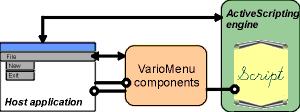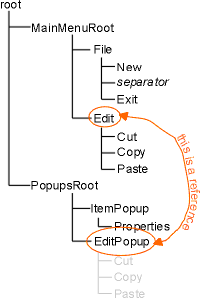What is VarioMenu?
VarioMenu is a set of ActiveX components which can create and dynamically maintain
Windows main and popup menus. The difference from the classic menu resources included
statically in every Windows application is that these menus are created at run-time and
VarioMenu components provide an easy way for changing and handling them. Since VarioMenu
objects are automation compatible and are designed to be used from scripts run from
ActiveScripting engines, the design and handling of the created menus is done by script.
This gives you the opportunity to create very flexible and dynamic menus for your
application needing only knowledge of some scripting language - JScript or VBScript for
example. The script can also handle the events related to menus and take the appropriate
actions.
How does it work?
VarioMenu architecture has three sides - the Windows application that makes use of the
menus, called a host; the VarioMenu components themself and the script that
creates and handles the menus. Host application creates and exposes VarioMenu objects to
the script. It also stands in touch with the menu components and attaches the created menu
to its window or refreshes it when it is updated. The script is hosted by the application
too. It is given the VarioMenu objects created uses them to access, modify and handle the
menus. Script functions are called to initially create the menu or are attached as events
to handle clicking a menu item.
The structure of a menu
VarioMenu architecture represents a simple object model for accessing menus. It
consists of three objects: one root object created and exposed by the host application
called VarioMenuTree; VarioMenuItem
object that models one menu item and can have several children and several parents.
Depending on what Type is specified for the menu
item, its children can form a popup menu, a drop-down menu or a radio group in a menu.
Finally there is one VarioMenuAccel object, which is
accessible for every menu item and configures accelerator keys for it, if this doesn't
conflict with its type.
Every menu item has a collection of children and each child can also be a parent of
other items. In that way a tree of menu items is formed. The host application can use some
items from the tree for root elements in order to create main menu for its window or a
popup menu.
Another feature is that one menu item can be placed at several locations in the tree -
every location keeps a reference to that item. If the item has children, they go with it.
So if you modify the state of this item or of its children, the change reflects all
locations e.g. all menus where is is present. That means you can create Edit submenu in
you main wondow's menu and then just place it once again in the appropriate place in the
tree to use it for popup menu.
If we take the tree of menu items on the right for exmaple: Edit menu item is inserted
(with all children) in PopupsRoot item under the name EditPopup. Note that in the nodes of
the tree are showed only the names under which menu items are located in the collections.
So EditPopup and Edit is one and the same object. The host application can create its main
window menu from MainMenuRoot node and the generated menu will contain all child items
under it. When needed, the application can track two popups, genrated from ItemPopup and
EditPopup nodes of the tree. The script creates Edit | Cut, Copy, Paste items only the
first time and sets their properties and event handlers. When it decides to create
EditPopup, which contains the same items, it just inserts Edit menu item object in
children's collection of PopupsRoot under the name EditPopup. From that point ahead, there
is no difference if you change the state of Cut under EditPopup or under Edit - it will
change on both places. |

